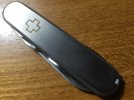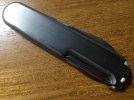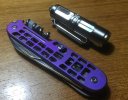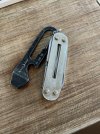- Joined
- Jun 4, 2018
- Messages
- 206
I have a couple of knives with an end broken off a cellidor scale. One breakage was from a fall to the floor - no great surprise but a disappointment nonetheless. The other was from sitting on the knife that was in my back pocket. I was flabbergasted at that one! While such damage doesn’t affect the knive’s functionality, I keep meaning to send them off to my local Vic importer to have the scales replaced - cheaper and more convenient than buying new scales from overseas.
Nylon scales are much stronger but harder to come by these days, and I doubt the agent would install them if I asked.
Aside from their near indestructibility (dings only add character), one of the great values of alox is that it makes the knife very easy to clean. My work knife is an alox Soldier and it can quickly become filthy with muck. A rinse under the tap, and a good shake to dry it, is usually all it takes to clean it. Crud can’t accumulate under the scales; nor does water drip from them into your pocket afterwards.
Nylon scales are much stronger but harder to come by these days, and I doubt the agent would install them if I asked.
Aside from their near indestructibility (dings only add character), one of the great values of alox is that it makes the knife very easy to clean. My work knife is an alox Soldier and it can quickly become filthy with muck. A rinse under the tap, and a good shake to dry it, is usually all it takes to clean it. Crud can’t accumulate under the scales; nor does water drip from them into your pocket afterwards.





